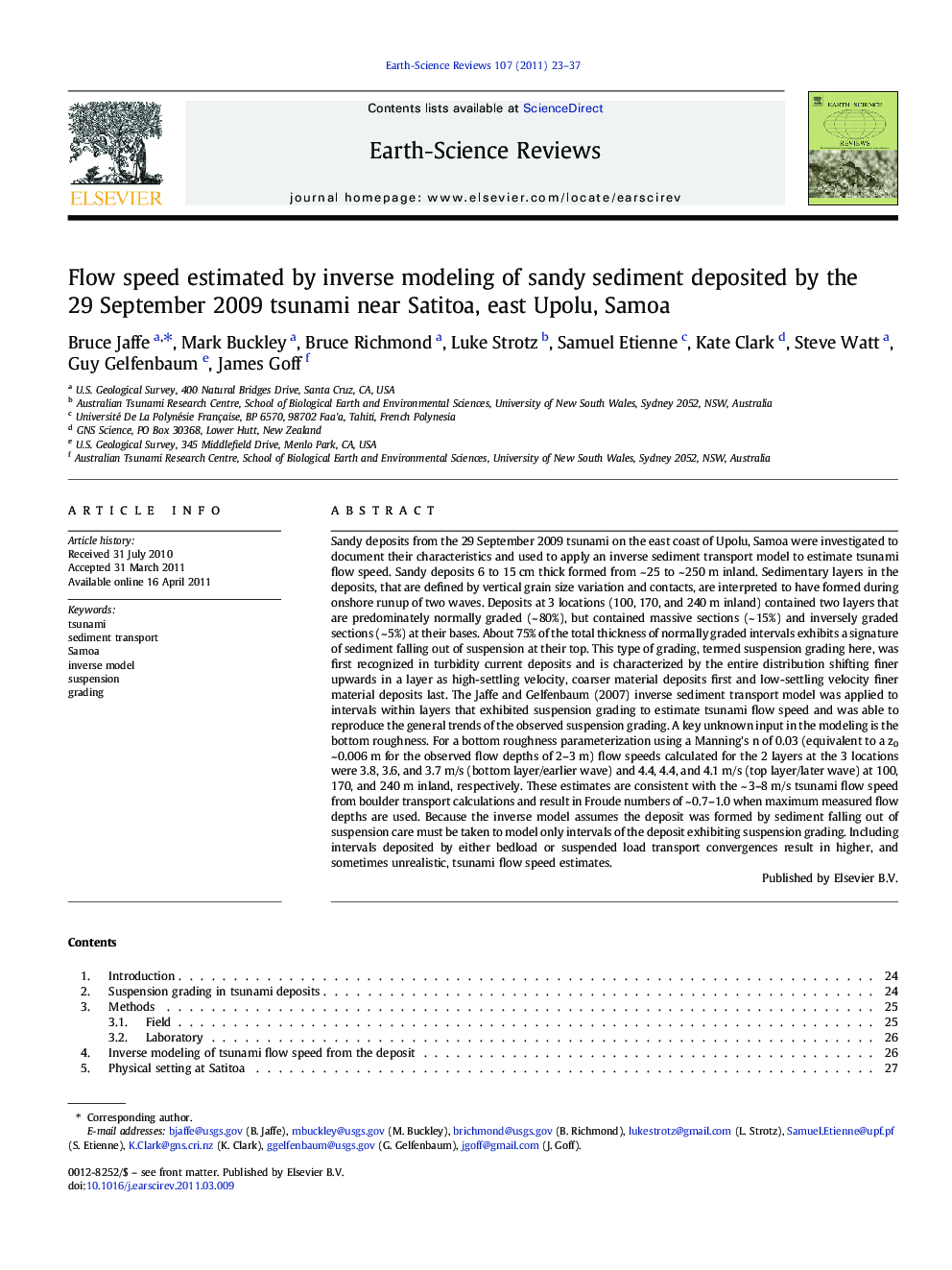| کد مقاله | کد نشریه | سال انتشار | مقاله انگلیسی | نسخه تمام متن |
|---|---|---|---|---|
| 6443188 | 1640002 | 2011 | 15 صفحه PDF | دانلود رایگان |
عنوان انگلیسی مقاله ISI
Flow speed estimated by inverse modeling of sandy sediment deposited by the 29 September 2009 tsunami near Satitoa, east Upolu, Samoa
دانلود مقاله + سفارش ترجمه
دانلود مقاله ISI انگلیسی
رایگان برای ایرانیان
کلمات کلیدی
موضوعات مرتبط
مهندسی و علوم پایه
علوم زمین و سیارات
زمین شناسی
پیش نمایش صفحه اول مقاله

چکیده انگلیسی
Sandy deposits from the 29 September 2009 tsunami on the east coast of Upolu, Samoa were investigated to document their characteristics and used to apply an inverse sediment transport model to estimate tsunami flow speed. Sandy deposits 6 to 15Â cm thick formed from ~Â 25 to ~Â 250Â m inland. Sedimentary layers in the deposits, that are defined by vertical grain size variation and contacts, are interpreted to have formed during onshore runup of two waves. Deposits at 3 locations (100, 170, and 240Â m inland) contained two layers that are predominately normally graded (~Â 80%), but contained massive sections (~Â 15%) and inversely graded sections (~Â 5%) at their bases. About 75% of the total thickness of normally graded intervals exhibits a signature of sediment falling out of suspension at their top. This type of grading, termed suspension grading here, was first recognized in turbidity current deposits and is characterized by the entire distribution shifting finer upwards in a layer as high-settling velocity, coarser material deposits first and low-settling velocity finer material deposits last. The Jaffe and Gelfenbaum (2007) inverse sediment transport model was applied to intervals within layers that exhibited suspension grading to estimate tsunami flow speed and was able to reproduce the general trends of the observed suspension grading. A key unknown input in the modeling is the bottom roughness. For a bottom roughness parameterization using a Manning's n of 0.03 (equivalent to a z0 ~Â 0.006Â m for the observed flow depths of 2-3Â m) flow speeds calculated for the 2 layers at the 3 locations were 3.8, 3.6, and 3.7Â m/s (bottom layer/earlier wave) and 4.4, 4.4, and 4.1Â m/s (top layer/later wave) at 100, 170, and 240Â m inland, respectively. These estimates are consistent with the ~Â 3-8Â m/s tsunami flow speed from boulder transport calculations and result in Froude numbers of ~Â 0.7-1.0 when maximum measured flow depths are used. Because the inverse model assumes the deposit was formed by sediment falling out of suspension care must be taken to model only intervals of the deposit exhibiting suspension grading. Including intervals deposited by either bedload or suspended load transport convergences result in higher, and sometimes unrealistic, tsunami flow speed estimates.
ناشر
Database: Elsevier - ScienceDirect (ساینس دایرکت)
Journal: Earth-Science Reviews - Volume 107, Issues 1â2, July 2011, Pages 23-37
Journal: Earth-Science Reviews - Volume 107, Issues 1â2, July 2011, Pages 23-37
نویسندگان
Bruce Jaffe, Mark Buckley, Bruce Richmond, Luke Strotz, Samuel Etienne, Kate Clark, Steve Watt, Guy Gelfenbaum, James Goff,